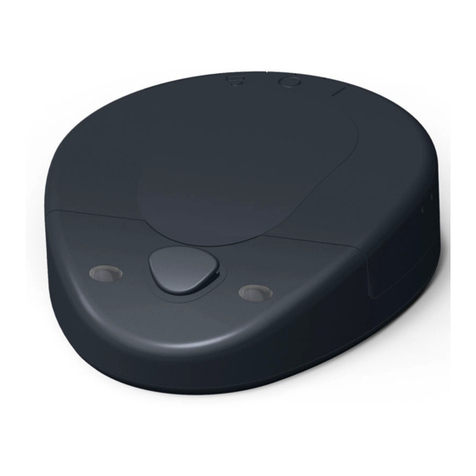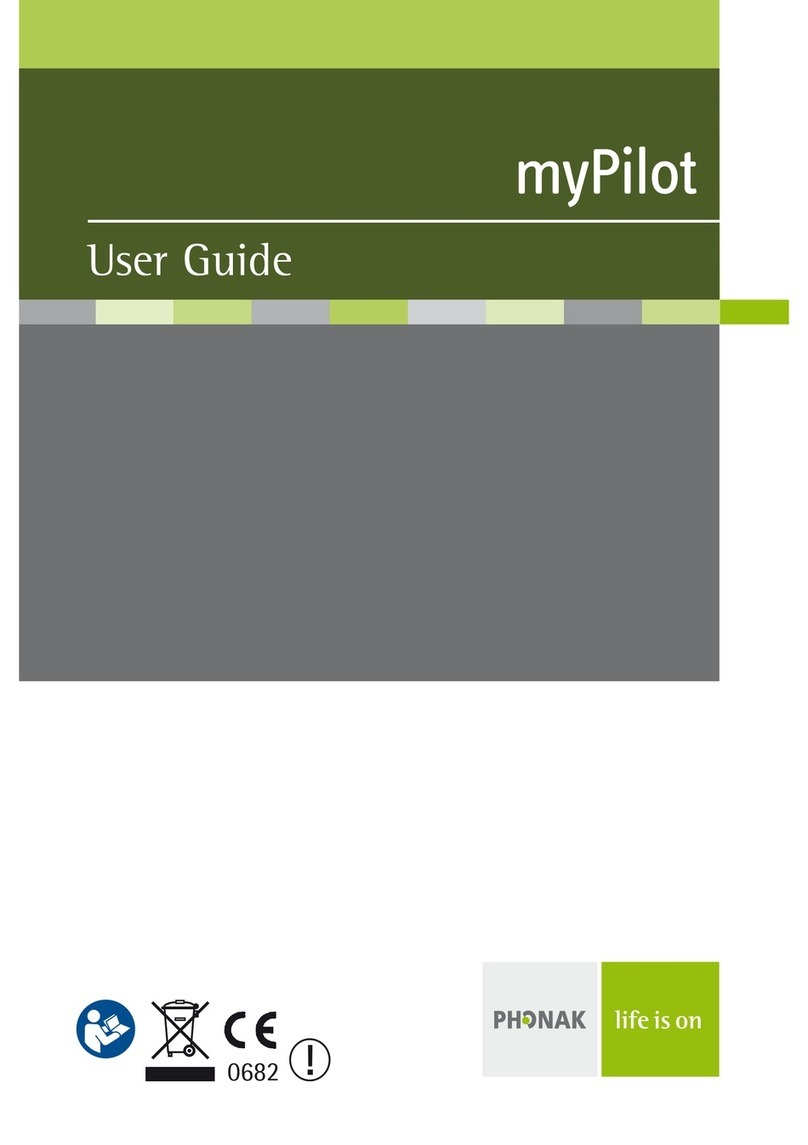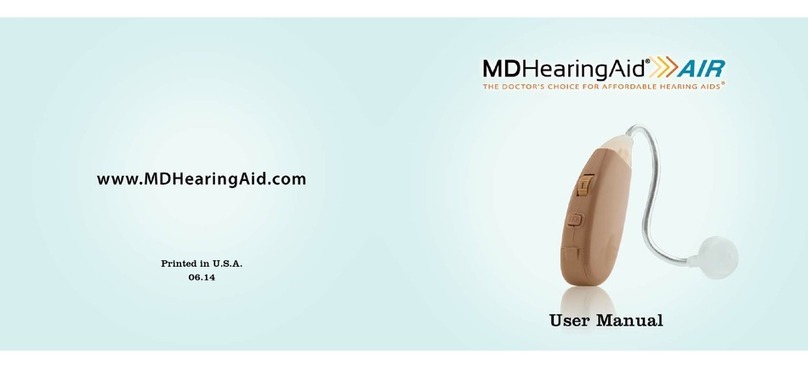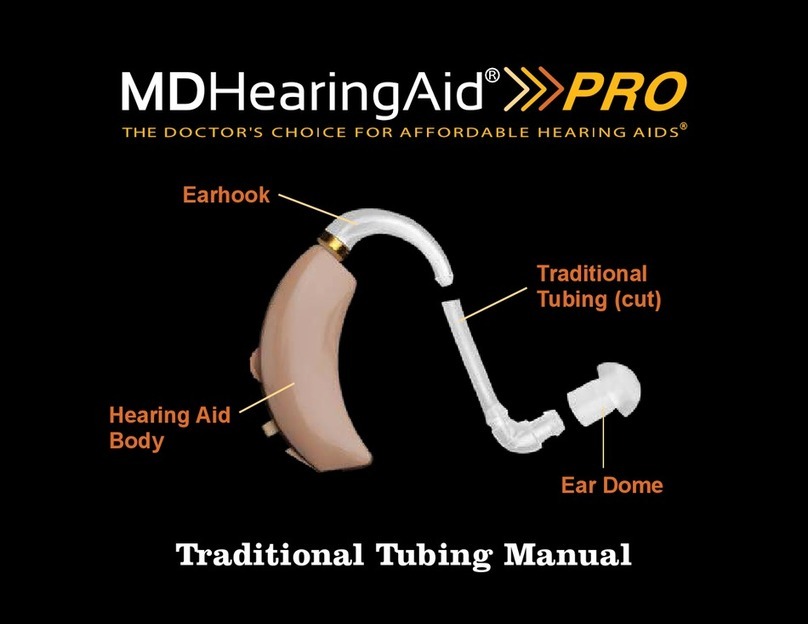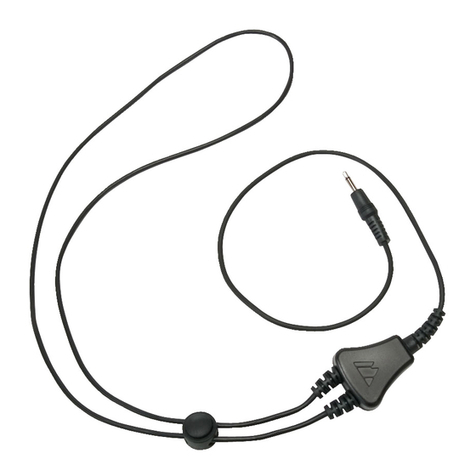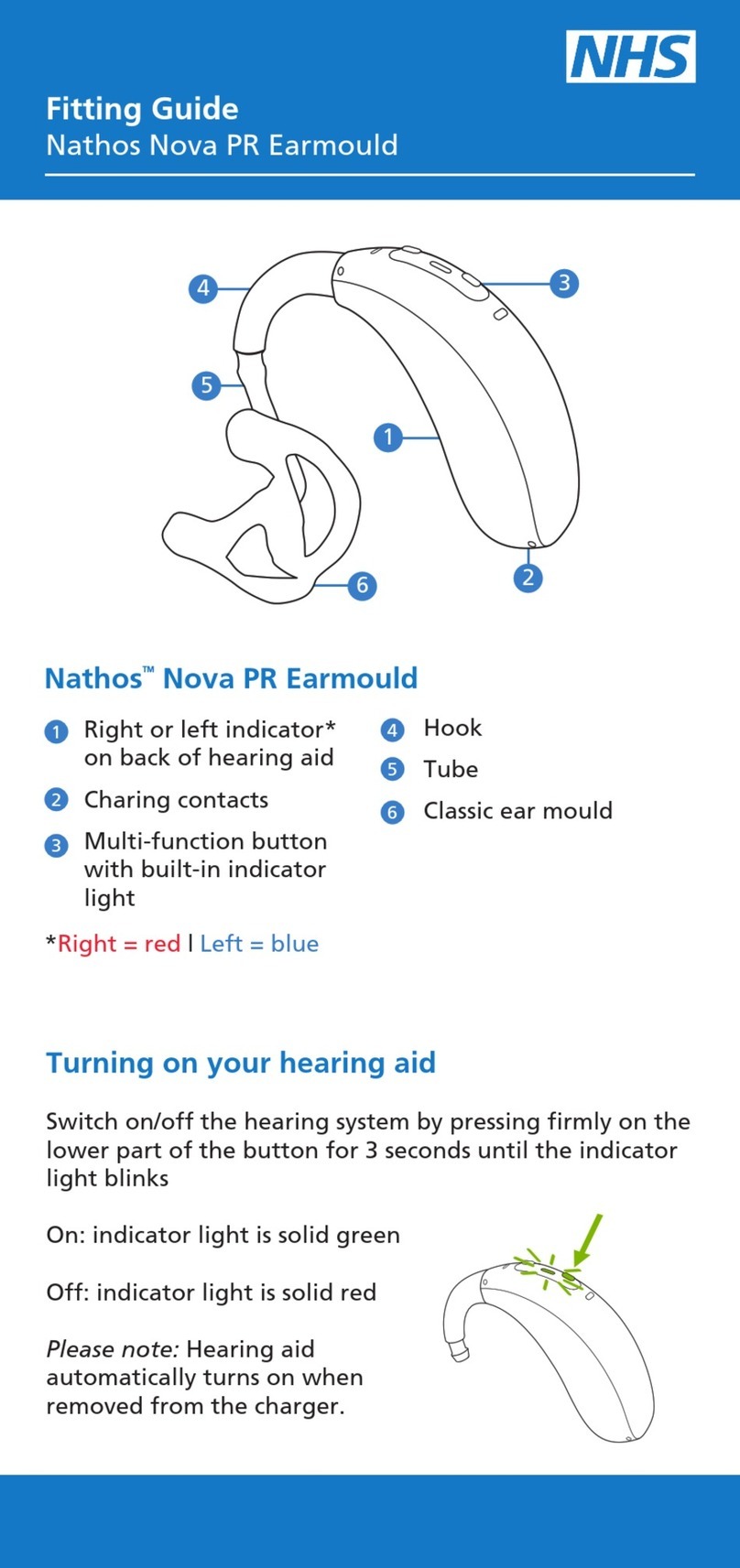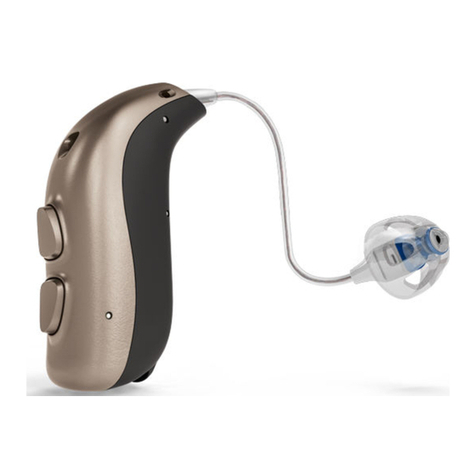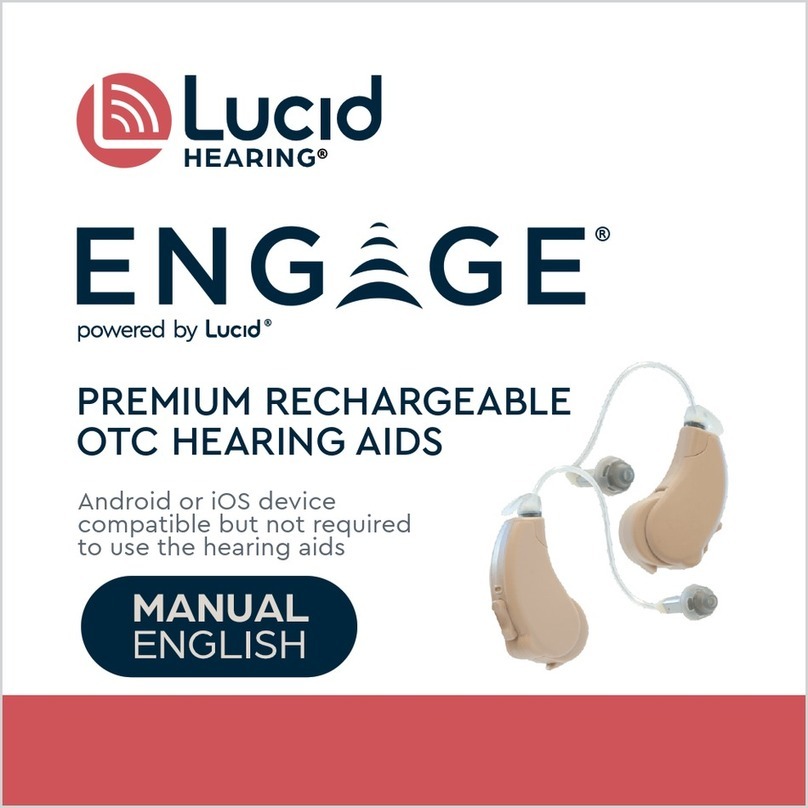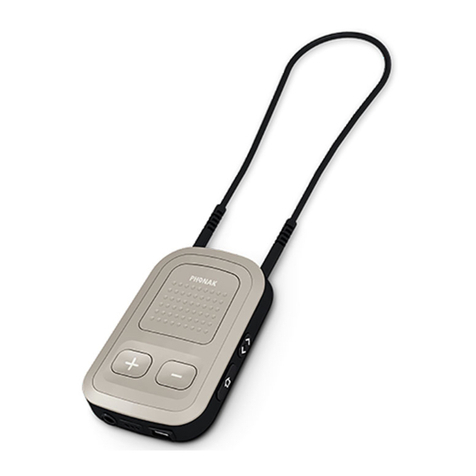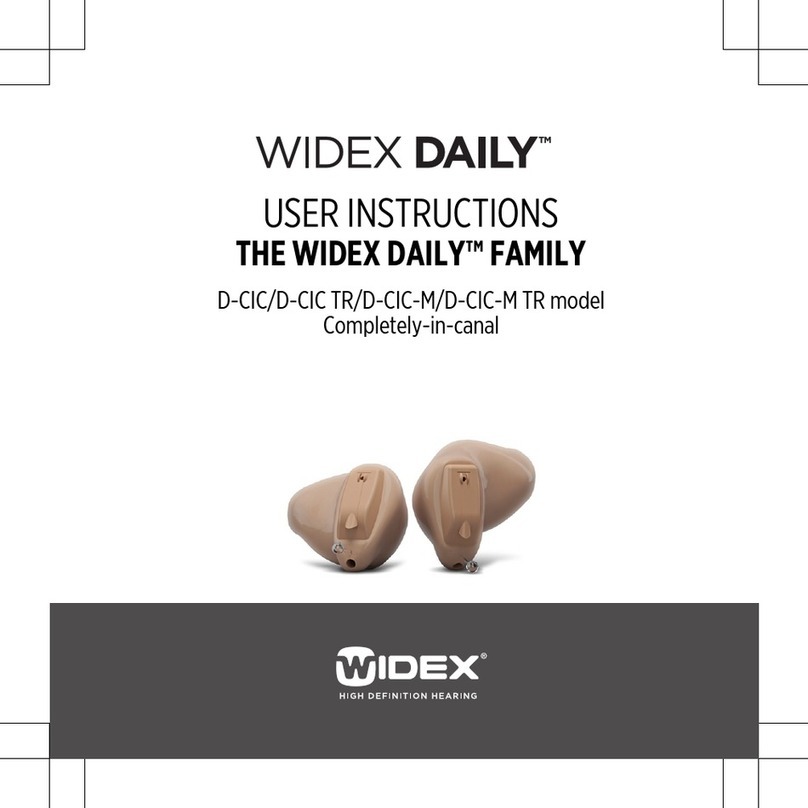Medel Mi1250 SYNCHRONY 2 User manual

Cochlear Implants
English
Kochleárny implantát
Mi1250 SYNCHRONY 2
Standard | Medium | Compressed | FLEXSOFT | FLEX28
FLEX26 | FLEX24 | FLEX20 | FORM24 | FORM19
Slovenčina
AW38654_1.0 (Slovak)

Typical dimensions in mm
* Recommended diameter of cochleostomy & RW opening
** Recommended insertion depth of electrode array
111.2
Mi1250 Standard 111.2
Mi1250 Medium 111.2
Mi1250 Compressed 111.2
Mi1250 FLEXSOFT 110.9
Mi1250 FLEX28 108.2
Mi1250 FLEX26 105.2
Mi1250 FLEX24 104.2
Mi1250 FLEX20 99.7
Mi1250 FORM24 102.7
Mi1250 FORM19 97.7
4.5
15°
30°
3.3
0.9
SYNCHRONY 2 Standard
SYNCHRONY 2 Medium
SYNCHRONY 2 Compressed
24
18.8
47.3
29
Standard Electrode array
2.4
26.4
31.5**
Ø 1.3*
Ø 0.5
Standard Electrode Array
111.2
Mi1250 Standard 111.2
Mi1250 Medium 111.2
Mi1250 Compressed 111.2
Mi1250 FLEXSOFT 110.9
Mi1250 FLEX28 108.2
Mi1250 FLEX26 105.2
Mi1250 FLEX24 104.2
Mi1250 FLEX20 99.7
Mi1250 FORM24 102.7
Mi1250 FORM19 97.7
4.5
15°
30°
3.3
0.9
24
18.8
47.3
29
111.2
Mi1250 Standard 111.2
Mi1250 Medium 111.2
Mi1250 Compressed 111.2
Mi1250 FLEXSOFT 110.9
Mi1250 FLEX28 108.2
Mi1250 FLEX26 105.2
Mi1250 FLEX24 104.2
Mi1250 FLEX20 99.7
Mi1250 FORM24 102.7
Mi1250 FORM19 97.7
4.5
15°
30°
3.3
0.9
24
18.8
47.3
29
Compressed Electrode Array
Medium Electrode Array
Medium Electrode array
24**
Ø 0.8*
Ø 0.5 20.9
1.9
Compressed Electrode array
15**
1.1
Ø 0.5 12.1 Ø 0.8*
2
3
5
6
8
7
9
1
Opening instruction
4
Inštrukcie na otváranie

1
Typical dimensions in mm
* Recommended diameter of cochleostomy & RW opening
** Recommended insertion depth of electrode array
111.2
Mi1250 Standard 111.2
Mi1250 Medium 111.2
Mi1250 Compressed 111.2
Mi1250 FLEXSOFT 110.9
Mi1250 FLEX28 108.2
Mi1250 FLEX26 105.2
Mi1250 FLEX24 104.2
Mi1250 FLEX20 99.7
Mi1250 FORM24 102.7
Mi1250 FORM19 97.7
4.5
15°
30°
3.3
0.9
SYNCHRONY 2 Standard
SYNCHRONY 2 Medium
SYNCHRONY 2 Compressed
24
18.8
47.3
29
Standard Electrode array
2.4
26.4
31.5**
Ø 1.3*
Ø 0.5
Standard Electrode Array
111.2
Mi1250 Standard 111.2
Mi1250 Medium 111.2
Mi1250 Compressed 111.2
Mi1250 FLEXSOFT 110.9
Mi1250 FLEX28 108.2
Mi1250 FLEX26 105.2
Mi1250 FLEX24 104.2
Mi1250 FLEX20 99.7
Mi1250 FORM24 102.7
Mi1250 FORM19 97.7
4.5
15°
30°
3.3
0.9
24
18.8
47.3
29
111.2
Mi1250 Standard 111.2
Mi1250 Medium 111.2
Mi1250 Compressed 111.2
Mi1250 FLEXSOFT 110.9
Mi1250 FLEX28 108.2
Mi1250 FLEX26 105.2
Mi1250 FLEX24 104.2
Mi1250 FLEX20 99.7
Mi1250 FORM24 102.7
Mi1250 FORM19 97.7
4.5
15°
30°
3.3
0.9
24
18.8
47.3
29
Compressed Electrode Array
Medium Electrode Array
Medium Electrode array
24**
Ø 0.8*
Ø 0.5 20.9
1.9
Compressed Electrode array
15**
1.1
Ø 0.5 12.1 Ø 0.8*
Typické rozmery v mm
* Odporúčaný priemer kochleostómie a okrúhleho okienka
** Odporúčaná hĺbka zavedenia elektródového poľa

2
Typical dimensions in mm
* Recommended diameter of cochleostomy & RW opening
** Recommended insertion depth of electrode array
104.2
Mi1250 Standard 111.2
Mi1250 Medium 111.2
Mi1250 Compressed 111.2
Mi1250 FLEXSOFT 110.9
Mi1250 FLEX28 108.2
Mi1250 FLEX26 105.2
Mi1250 FLEX24 104.2
Mi1250 FLEX20 99.7
Mi1250 FORM24 102.7
Mi1250 FORM19 97.7
4.5
15°
30°
3.3
0.9
SYNCHRONY 2 FLEX24
SYNCHRONY 2 FLEX20
SYNCHRONY 2 FORM24
24
18.8
47.3
29
FLEX24 Electrode Array
99.7
Mi1250 Standard 111.2
Mi1250 Medium 111.2
Mi1250 Compressed 111.2
Mi1250 FLEXSOFT 110.9
Mi1250 FLEX28 108.2
Mi1250 FLEX26 105.2
Mi1250 FLEX24 104.2
Mi1250 FLEX20 99.7
Mi1250 FORM24 102.7
Mi1250 FORM19 97.7
4.5
15°
30°
3.3
0.9
24
18.8
47.3
29
102.7
Mi1250 Standard 111.2
Mi1250 Medium 111.2
Mi1250 Compressed 111.2
Mi1250 FLEXSOFT 110.9
Mi1250 FLEX28 108.2
Mi1250 FLEX26 105.2
Mi1250 FLEX24 104.2
Mi1250 FLEX20 99.7
Mi1250 FORM24 102.7
Mi1250 FORM19 97.7
4.5
15°
30°
3.3
0.9
24
18.8
47.3
29
FORM24 Electrode Array
FLEX20 Electrode Array
24**
1.9
20.9Ø 0.3
Ø 0.5
Ø 0.8*
FLEX24 Electrode array
FLEX20 Electrode array
1.4
15.4Ø 0.3
Ø 0.5
Ø 0.8*
20**
FORM24 Electrode array
1.7 2.4
18.7Ø 0.5 Ø 0.8*
Ø 1.9*
24**
Typical dimensions in mm
* Recommended diameter of cochleostomy & RW opening
** Recommended insertion depth of electrode array
110.9
Mi1250 Standard 111.2
Mi1250 Medium 111.2
Mi1250 Compressed 111.2
Mi1250 FLEXSOFT 110.9
Mi1250 FLEX28 108.2
Mi1250 FLEX26 105.2
Mi1250 FLEX24 104.2
Mi1250 FLEX20 99.7
Mi1250 FORM24 102.7
Mi1250 FORM19 97.7
4.5
15°
30°
3.3
0.9
SYNCHRONY 2 FLEXSOFT
SYNCHRONY 2 FLEX28
SYNCHRONY 2 FLEX26
24
18.8
47.3
29
FLEXSOFT Electrode Array
108.2
Mi1250 Standard 111.2
Mi1250 Medium 111.2
Mi1250 Compressed 111.2
Mi1250 FLEXSOFT 110.9
Mi1250 FLEX28 108.2
Mi1250 FLEX26 105.2
Mi1250 FLEX24 104.2
Mi1250 FLEX20 99.7
Mi1250 FORM24 102.7
Mi1250 FORM19 97.7
4.5
15°
30°
3.3
0.9
24
18.8
47.3
29
105.2
Mi1250 Standard 111.2
Mi1250 Medium 111.2
Mi1250 Compressed 111.2
Mi1250 FLEXSOFT 110.9
Mi1250 FLEX28 108.2
Mi1250 FLEX26 105.2
Mi1250 FLEX24 104.2
Mi1250 FLEX20 99.7
Mi1250 FORM24 102.7
Mi1250 FORM19 97.7
4.5
15°
30°
3.3
0.9
24
18.8
47.3
29
FLEX26 Electrode Array
FLEX28 Electrode Array
FLEXSOFT Electrode array
31.5**
2.4
26.4Ø 0.4
Ø 0.5
Ø 1.3*
FLEX28 Electrode array
28**
2.1
23.1Ø 0.4
Ø 0.5
Ø 0.8*
FLEX26 Electrode array
26**
1.9
20.9Ø 0.3
Ø 0.5
Ø 0.8*
Typické rozmery v mm
* Odporúčaný priemer kochleostómie a okrúhleho okienka
** Odporúčaná hĺbka zavedenia elektródového poľa

3
Typical dimensions in mm
* Recommended diameter of cochleostomy & RW opening
** Recommended insertion depth of electrode array
104.2
Mi1250 Standard 111.2
Mi1250 Medium 111.2
Mi1250 Compressed 111.2
Mi1250 FLEXSOFT 110.9
Mi1250 FLEX28 108.2
Mi1250 FLEX26 105.2
Mi1250 FLEX24 104.2
Mi1250 FLEX20 99.7
Mi1250 FORM24 102.7
Mi1250 FORM19 97.7
4.5
15°
30°
3.3
0.9
SYNCHRONY 2 FLEX24
SYNCHRONY 2 FLEX20
SYNCHRONY 2 FORM24
24
18.8
47.3
29
FLEX24 Electrode Array
99.7
Mi1250 Standard 111.2
Mi1250 Medium 111.2
Mi1250 Compressed 111.2
Mi1250 FLEXSOFT 110.9
Mi1250 FLEX28 108.2
Mi1250 FLEX26 105.2
Mi1250 FLEX24 104.2
Mi1250 FLEX20 99.7
Mi1250 FORM24 102.7
Mi1250 FORM19 97.7
4.5
15°
30°
3.3
0.9
24
18.8
47.3
29
102.7
Mi1250 Standard 111.2
Mi1250 Medium 111.2
Mi1250 Compressed 111.2
Mi1250 FLEXSOFT 110.9
Mi1250 FLEX28 108.2
Mi1250 FLEX26 105.2
Mi1250 FLEX24 104.2
Mi1250 FLEX20 99.7
Mi1250 FORM24 102.7
Mi1250 FORM19 97.7
4.5
15°
30°
3.3
0.9
24
18.8
47.3
29
FORM24 Electrode Array
FLEX20 Electrode Array
24**
1.9
20.9Ø 0.3
Ø 0.5
Ø 0.8*
FLEX24 Electrode array
FLEX20 Electrode array
1.4
15.4Ø 0.3
Ø 0.5
Ø 0.8*
20**
FORM24 Electrode array
1.7 2.4
18.7
Ø 0.5 Ø 0.8*
Ø 1.9*
24**
Typical dimensions in mm
* Recommended diameter of cochleostomy & RW opening
** Recommended insertion depth of electrode array
110.9
Mi1250 Standard 111.2
Mi1250 Medium 111.2
Mi1250 Compressed 111.2
Mi1250 FLEXSOFT 110.9
Mi1250 FLEX28 108.2
Mi1250 FLEX26 105.2
Mi1250 FLEX24 104.2
Mi1250 FLEX20 99.7
Mi1250 FORM24 102.7
Mi1250 FORM19 97.7
4.5
15°
30°
3.3
0.9
SYNCHRONY 2 FLEXSOFT
SYNCHRONY 2 FLEX28
SYNCHRONY 2 FLEX26
24
18.8
47.3
29
FLEXSOFT Electrode Array
108.2
Mi1250 Standard 111.2
Mi1250 Medium 111.2
Mi1250 Compressed 111.2
Mi1250 FLEXSOFT 110.9
Mi1250 FLEX28 108.2
Mi1250 FLEX26 105.2
Mi1250 FLEX24 104.2
Mi1250 FLEX20 99.7
Mi1250 FORM24 102.7
Mi1250 FORM19 97.7
4.5
15°
30°
3.3
0.9
24
18.8
47.3
29
105.2
Mi1250 Standard 111.2
Mi1250 Medium 111.2
Mi1250 Compressed 111.2
Mi1250 FLEXSOFT 110.9
Mi1250 FLEX28 108.2
Mi1250 FLEX26 105.2
Mi1250 FLEX24 104.2
Mi1250 FLEX20 99.7
Mi1250 FORM24 102.7
Mi1250 FORM19 97.7
4.5
15°
30°
3.3
0.9
24
18.8
47.3
29
FLEX26 Electrode Array
FLEX28 Electrode Array
FLEXSOFT Electrode array
31.5**
2.4
26.4Ø 0.4
Ø 0.5
Ø 1.3*
FLEX28 Electrode array
28**
2.1
23.1Ø 0.4
Ø 0.5
Ø 0.8*
FLEX26 Electrode array
26**
1.9
20.9Ø 0.3
Ø 0.5
Ø 0.8*
Typické rozmery v mm
* Odporúčaný priemer kochleostómie a okrúhleho okienka
** Odporúčaná hĺbka zavedenia elektródového poľa

4
Typical dimensions in mm
* Recommended diameter of cochleostomy & RW opening
** Recommended insertion depth of electrode array
97.7
Mi1250 Standard 111.2
Mi1250 Medium 111.2
Mi1250 Compressed 111.2
Mi1250 FLEXSOFT 110.9
Mi1250 FLEX28 108.2
Mi1250 FLEX26 105.2
Mi1250 FLEX24 104.2
Mi1250 FLEX20 99.7
Mi1250 FORM24 102.7
Mi1250 FORM19 97.7
4.5
15°
30°
3.3
0.9
SYNCHRONY 2 FORM19
24
18.8
47.3
29
FORM19 Electrode Array
FORM19 Electrode array
19**
2.4
1.3
14.3Ø 0.5 Ø 0.8*
Ø 1.9*
Typické rozmery v mm
* Odporúčaný priemer kochleostómie a okrúhleho okienka
** Odporúčaná hĺbka zavedenia elektródového poľa

5
Typical dimensions in mm
* Recommended diameter of cochleostomy & RW opening
** Recommended insertion depth of electrode array
97.7
Mi1250 Standard 111.2
Mi1250 Medium 111.2
Mi1250 Compressed 111.2
Mi1250 FLEXSOFT 110.9
Mi1250 FLEX28 108.2
Mi1250 FLEX26 105.2
Mi1250 FLEX24 104.2
Mi1250 FLEX20 99.7
Mi1250 FORM24 102.7
Mi1250 FORM19 97.7
4.5
15°
30°
3.3
0.9
SYNCHRONY 2 FORM19
24
18.8
47.3
29
FORM19 Electrode Array
FORM19 Electrode array
19**
2.4
1.3
14.3Ø 0.5 Ø 0.8*
Ø 1.9*
5
Instructions for use
Mi1250 SYNCHRONY 2 Cochlear Implant
Device description
The Mi1250 SYNCHRONY 2 Cochlear Implant (hereafter referred to as SYNCHRONY 2) is
the implantable part of the MED‑EL Hearing Implant System and can only be used to‑
gether with compatible MED‑EL external components. The device consists of a stimula‑
tor, a coil with a removable magnet within its centre, a reference electrode, an EAP ref‑
erence electrode and an active electrode permanently attached to the stimulator. The
active electrode can be of different types, thus resulting in different implant variants
(implant family SYNCHRONY 2). This device is intended to be implanted by adequately
trained and experienced surgeons only.
The implant offers a stimulation mode and a telemetry mode. Stimulation sequences
of biphasic and triphasic pulses can be delivered sequentially or simultaneously on two
or more channels. In telemetry mode the device allows a functional check about the
technical status of the implant including communication over the transcutaneous link
as well as the assessment of the electrode impedances and recording of the electrically
evoked compound action potential of the hearing nerve.
The implant has a mass of 7.7 g (typical weight).
For principal dimensions of the implant refer to the drawings on the previous pages.
The volume of the implant without electrode is 3.9 cm³.
Following materials are in direct contact with human tissue: medical grade silicone,
platinum, iridium and parylene c.
Purpose of the device
Perception of environmental sound and potential for improvement of communicational
abilities.
Performance characteristics
• Output characteristics of a stimulation signal on a 1 kOhm resistor:
Maximum current amplitude: Median value = 1250 µA, range = 500µA
Maximum pulse width: Median value = 203.8 µs, range = 8.2 µs
• The impedance measurement accuracy is typically better than 5%.
• The implant is MR Conditional for scanner eld strengths of 0.2 Tesla, 1.0 Tesla, 1.5
Tesla and 3.0 Tesla. For more information please refer to Medical Procedures Manual.
• There are no default factory settings of the implant system.
• Proper functioning of the implantable part of the CI system can be checked by
performing telemetry (refer to MED‑EL application software user manual).
ENGLISH
Typical dimensions in mm
* Recommended diameter of cochleostomy & RW opening
** Recommended insertion depth of electrode array
97.7
Mi1250 Standard 111.2
Mi1250 Medium 111.2
Mi1250 Compressed 111.2
Mi1250 FLEXSOFT 110.9
Mi1250 FLEX28 108.2
Mi1250 FLEX26 105.2
Mi1250 FLEX24 104.2
Mi1250 FLEX20 99.7
Mi1250 FORM24 102.7
Mi1250 FORM19 97.7
4.5
15°
30°
3.3
0.9
SYNCHRONY 2 FORM19
24
18.8
47.3
29
FORM19 Electrode Array
FORM19 Electrode array
19**
2.4
1.3
14.3Ø 0.5 Ø 0.8*
Ø 1.9*

6
6
English
Specication and characteristics for each lead and electrode array
• The implant has 24 independent current sources stimulating 12 independent elec‑
trode channels in monopolar mode.
• The electrode is made of medical grade silicone, platinum (electrode contacts) and
platinum/iridium (90/10) wires and PEEK.
• All electrode variants have a straight design. The electrode does not deliver any
medicinal substances.
• Geometric surface area of the stimulation reference electrode = 50mm².
• Physical dimensions of the electrodes:
Electrode type Length
of the
electrode
lead *
Cross-sectional dimen-
sions of the electrode
array
Geometric surface
area per channel
Distance
at proximal
end of array *
at distal end
of array *
of smallest
stimulating
electrode
contact **
of largest
stimulating
electrode
contact **
between
contacts *
between
most proxi‑
mal and
most distal
contact *
Standard 111.2 1.3 × 1.3 0.5 × 0.5 0.14 0.14 2.4 26.4
Medium 111.2 0.8 × 0.8 0.5 × 0.5 0.14 0.14 1.9 20.9
Compressed 111.2 0.7 × 0.7 0.5 × 0.5 0.14 0.14 1.1 12.1
FLEXSOFT 110.9 1.3 × 1.3 0.5 × 0.4 0.13 0.14 2.4 26.4
FLEX28 108.2 0.8 × 0.8 0.5 × 0.4 0.13 0.14 2.1 23.1
FLEX26 105.2 0.8 × 0.8 0.5 × 0.3 0.13 0.14 1.9 20.9
FLEX24 104.2 0.8 × 0.8 0.5 × 0.3 0.13 0.14 1.9 20.9
FLEX20 99.7 0.8 × 0.8 0.5 × 0.3 0.13 0.14 1.4 15.4
FORM24 102.7 0.8 × 0.8 0.5 × 0.5 0.14 0.14 1.7 18.7
FORM19 97.7 0.8 × 0.8 0.5 × 0.5 0.14 0.14 1.3 14.3
* typical value, mm ** typical value, mm²
The implant does not have any connector.
Some implant electrode types mentioned in these Instructions for Use may not be
released for distribution in all markets. Please contact your local MED‑EL representative
for information on current product availability in your country.
Intended use
The MED‑EL Cochlear Implant System is intended to evoke auditory sensations via elec‑
trical stimulation of the auditory pathways for severely to profoundly hearing impaired
individuals who obtain little or no benet from acoustic amplication in the best aided
condition.

7
7
English
Additionally the MED‑EL Cochlear Implant System used in combination with the implant
variant SYNCHRONY 2 FLEX24 is intended to evoke auditory sensations via electrical
stimulation or via combined electric‑acoustic stimulation (EAS) of the auditory path‑
ways for partially deaf individuals, who obtain benet from acoustic amplication in the
lower frequencies only.
Additionally, the MED‑EL Cochlear Implant System used in combination with the implant
variants SYNCHRONY 2 FLEX20 is intended to evoke auditory sensations via electrical
stimulation or via combined electric‑acoustic stimulation (EAS) of the auditory path‑
ways for partially deaf individuals, who obtain benet from acoustic amplication in the
lower frequencies only.
The MED‑EL Cochlear Implant System is also intended to evoke auditory sensations via
electrical stimulation of the auditory pathways for individuals with single–sided deaf‑
ness, which is dened as severe to profound hearing impairment in one ear and normal
hearing or mild to moderate hearing impairment in the other ear.
Indications
• The cochlear implant evokes acoustic perception via electrical stimulation of the
auditory nerve. A functional auditory nerve is thus a prerequisite for successful
cochlear implantation.
• MED‑EL strongly recommends using optimally tted hearing aids for a minimum of
three months before deciding that a cochlear implant is the preferential option.
However, if an individual was deafened by an infectious disease, which can lead to
ossication and if there are signs of cochlear ossication there may be no need to
try a hearing aid. In these cases, implantation should not usually be delayed.
• To obtain the optimal benet from the implant, the prospective implant users and
their families shall be highly motivated and have realistic expectations about the
expected benet of the implant and shall understand the importance of returning
to the implant centre for regular audio processor programming, assessment ses‑
sions and training.
• A preoperative assessment according to the local professional standards must be
conducted.
• Cochlear implants SYNCHRONY 2 Standard are intended to be used in open
cochleae (no obliteration or ossication) for an electrode insertion depth of about
31mm.
• Cochlear implants SYNCHRONY 2 Medium are intended to be used in open cochleae
(no obliteration or ossication) with mild malformation for an electrode insertion
depth of about 24mm as per request of the surgeon.

8
8
English
• Cochlear implants SYNCHRONY 2 Compressed are intended to be used in cochleae
with moderate obliteration, ossication, or malformation for an electrode insertion
depth of about 15mm as per request of the surgeon.
• Cochlear implants SYNCHRONY 2 FLEXSOFT are intended to be used in open cochleae
(no obliteration or ossication) for an electrode insertion depth of about 31mm.
• Cochlear implants SYNCHRONY 2 FLEX28 are intended to be used in open cochleae
(no obliteration or ossication) for an electrode insertion depth of about 28mm.
• Cochlear implants SYNCHRONY 2 FLEX26 are intended to be used in open cochleae
(no obliteration or ossication) for an electrode insertion depth of about 26mm.
• Cochlear implants SYNCHRONY 2 FLEX24 for non‑EAS indication are intended to be
used in open cochleae (no obliteration or ossication) for an electrode insertion
depth of about 24mm as per request of the surgeon.
• Cochlear implants SYNCHRONY 2 FLEX24 used for EAS are indicated for partially deaf
individuals with mild to moderate sensorineural hearing loss in the low frequencies,
sloping to a profound sensorineural hearing loss in the high frequencies.
• Cochlear implants SYNCHRONY 2 FLEX20 for non‑EAS indication are intended to be
used in open cochleae (no obliteration or ossication) for an electrode insertion
depth of about 20mm as per request of the surgeon.
• Cochlear implants SYNCHRONY 2 FLEX20 used for EAS are indicated for partially deaf
individuals with mild to moderate sensorineural hearing loss in the low frequencies,
sloping to a profound sensorineural hearing loss in high frequencies.
• Cochlear implants SYNCHRONY 2 FORM24 are intended to be used in open cochleae
(no obliteration or ossication) or in cochleae with malformation for an electrode
insertion depth of about 24mm and/or when cerebrospinal uid (CSF) leakage is
expected.
• Cochlear implants SYNCHRONY 2 FORM19 are intended to be used in cochleae with
malformation, obliteration or ossication for an electrode insertion depth of about
19mm and/or when cerebrospinal uid (CSF) leakage is expected.
Contraindications
An individual must not be implanted,
• if the individual is known to be intolerant of the materials used in the implant
(including medical grade silicone, platinum, iridium and parylene c);
• if there is an absence of cochlear development;
• if the cause of deafness is non‑functionality of the auditory nerve and/or the upper
auditory pathway;
• if external or middle ear infections are present or if the tympanic membrane is
perforated in the ear to be implanted;
• if there are medical contraindications to surgery of the middle and inner ear and
anaesthesia as required;

9
8
English
• Cochlear implants SYNCHRONY 2 Compressed are intended to be used in cochleae
with moderate obliteration, ossication, or malformation for an electrode insertion
depth of about 15mm as per request of the surgeon.
• Cochlear implants SYNCHRONY 2 FLEXSOFT are intended to be used in open cochleae
(no obliteration or ossication) for an electrode insertion depth of about 31mm.
• Cochlear implants SYNCHRONY 2 FLEX28 are intended to be used in open cochleae
(no obliteration or ossication) for an electrode insertion depth of about 28mm.
• Cochlear implants SYNCHRONY 2 FLEX26 are intended to be used in open cochleae
(no obliteration or ossication) for an electrode insertion depth of about 26mm.
• Cochlear implants SYNCHRONY 2 FLEX24 for non‑EAS indication are intended to be
used in open cochleae (no obliteration or ossication) for an electrode insertion
depth of about 24mm as per request of the surgeon.
• Cochlear implants SYNCHRONY 2 FLEX24 used for EAS are indicated for partially deaf
individuals with mild to moderate sensorineural hearing loss in the low frequencies,
sloping to a profound sensorineural hearing loss in the high frequencies.
• Cochlear implants SYNCHRONY 2 FLEX20 for non‑EAS indication are intended to be
used in open cochleae (no obliteration or ossication) for an electrode insertion
depth of about 20mm as per request of the surgeon.
• Cochlear implants SYNCHRONY 2 FLEX20 used for EAS are indicated for partially deaf
individuals with mild to moderate sensorineural hearing loss in the low frequencies,
sloping to a profound sensorineural hearing loss in high frequencies.
• Cochlear implants SYNCHRONY 2 FORM24 are intended to be used in open cochleae
(no obliteration or ossication) or in cochleae with malformation for an electrode
insertion depth of about 24mm and/or when cerebrospinal uid (CSF) leakage is
expected.
• Cochlear implants SYNCHRONY 2 FORM19 are intended to be used in cochleae with
malformation, obliteration or ossication for an electrode insertion depth of about
19mm and/or when cerebrospinal uid (CSF) leakage is expected.
Contraindications
An individual must not be implanted,
• if the individual is known to be intolerant of the materials used in the implant
(including medical grade silicone, platinum, iridium and parylene c);
• if there is an absence of cochlear development;
• if the cause of deafness is non‑functionality of the auditory nerve and/or the upper
auditory pathway;
• if external or middle ear infections are present or if the tympanic membrane is
perforated in the ear to be implanted;
• if there are medical contraindications to surgery of the middle and inner ear and
anaesthesia as required;
9
English
• if anatomic abnormalities are present that would prevent appropriate placement of
the stimulator housing in the bone of the skull or prevent placement of the chosen
electrode array into the cochlea, using the implant shall be carefully considered
prior to surgery;
• if the psychological status of the individual is unstable or
• if the individual has unrealistic expectations.
Implantation of Cochlear implants SYNCHRONY 2 FLEX24 used for EAS is contraindicated
for partially deaf individuals with strong progressive hearing loss who are unable to use
amplication devices and/or have cochlear malformations.
Implantation of Cochlear implants SYNCHRONY 2 FLEX20 used for EAS is contraindicated
for partially deaf individuals with strong progressive hearing loss who are unable to use
amplication devices and/or have cochlear malformations.
Undesirable side effects – Risks related to the implant
Possible postoperative side effects include the following: loss of residual hearing, dizzi‑
ness, increased vertigo, delay of healing of the scar, impairment of the sense of taste,
potential for swallowing difculties, numbness, increased tinnitus, stimulation of the
facial nerve, temporary pain and uncomfortable sounds during stimulation.
Sterility
The implant has been subjected to a validated ethylene oxide sterilisation process and
is supplied in sterile packaging. Once the sterile packaging has been opened, the im‑
plant cannot be resterilised. Do not use if sterile packaging is damaged. The implant is
for single use only. Do not remove from sterile packaging until required.
Storage,shipment and disposal
The sterilised implant may only be shipped¹ between –29 °C (–20.2°F) and +60 °C
(+140°F) and stored inside the implant box at room temperature. Each device must
be implanted before the use‑by date specied on the package. Packaging² should be
disposed of in accordance with local legislation.
Information about use – General precautions and warnings
• The device must not be altered and must only be used as intended.
• Expected performance with the cochlear implant cannot be accurately predicted.
The prospective implant users and their families shall be highly motivated and have
realistic expectations about the expected benet of the implant.
• Long‑term damage to neural tissue following continuous chronic electrical stimula‑
tion has not been observed with cochlear implants.
• Sterility of the implant must be ensured at all times.

10
10
English
• The implant must never be dropped onto a hard surface or be held only by the
electrode; damage to the implant or electrodes during implantation will invalidate
the warranty.
• Device failure may occur due to mechanical damage of the implanted parts, e.g.
resulting from a blow to the head, or due to electronic or other technical failure of
the implant. Replacement of the device is required in these cases.
• For important information regarding everyday use of the MED‑EL Cochlear Implant
System and the applicable audio processor please consult the audio processor user
manual.
• Particular attention should be paid to paediatric patients with developmental chal‑
lenges (e.g. Cornelia‑de‑Lange syndrome), as they may present an increased risk of
suffocation and/or laryngeal injury from attempting to swallow the coil and/or other
external parts.
• Middle ear infection or a temporary loss of lymphatic uid in cochlea can lead to
temporarily elevated electrode impedances or impedance uctuations. Such imped‑
ance uctuations can cause variation in loudness which may in some cases resolve
on its own over the course of a few weeks, other cases may require surgical inter‑
vention.
• Most water sports should not cause any problem as long as the external parts of
the implant system are removed. If headgear or face mask are worn, care must be
taken to ensure that the strap is not too tight over the site of the implant. In case
the MED‑EL implant user wants to dive, the user should consult an experienced
physician about the possibilities and personal restrictions when performing water
sports, especially in the case of SCUBA diving. The implant is robust against pres‑
sure changes which occur during SCUBA diving to depths up to 50m (165ft).
Surgical precautions and warnings – Risks related to surgery
• Cochlear implant surgery is comparable to middle ear surgery with additional access
to the inner ear. The normal risks of surgery and general anaesthesia are applicable.
Primary surgical risks include the following: infection, inammation, swelling, ne‑
crosis, haematoma, leakage of CSF, damage to the facial nerve, pain, scarring of the
wound, skin irritation, swallowing difculties and complications related to general
anaesthesia. Additionally, meningitis³ can be a rare postoperative complication, but
has the potential to be serious. The risk of meningitis may be reduced, for example
by vaccination, antibiotic cover, and surgical technique.
• If available, facial nerve monitoring is recommended and if carried out, neural mus‑
cular blockade should be avoided.
• Prophylactic use of antibiotics is recommended for all implant recipients unless
medically contraindicated.
• Clear identication of the anatomical landmarks is required. When drilling, care
should be taken to avoid exposing the dura inadvertently. If the dura is exposed

11
10
English
• The implant must never be dropped onto a hard surface or be held only by the
electrode; damage to the implant or electrodes during implantation will invalidate
the warranty.
• Device failure may occur due to mechanical damage of the implanted parts, e.g.
resulting from a blow to the head, or due to electronic or other technical failure of
the implant. Replacement of the device is required in these cases.
• For important information regarding everyday use of the MED‑EL Cochlear Implant
System and the applicable audio processor please consult the audio processor user
manual.
• Particular attention should be paid to paediatric patients with developmental chal‑
lenges (e.g. Cornelia‑de‑Lange syndrome), as they may present an increased risk of
suffocation and/or laryngeal injury from attempting to swallow the coil and/or other
external parts.
• Middle ear infection or a temporary loss of lymphatic uid in cochlea can lead to
temporarily elevated electrode impedances or impedance uctuations. Such imped‑
ance uctuations can cause variation in loudness which may in some cases resolve
on its own over the course of a few weeks, other cases may require surgical inter‑
vention.
• Most water sports should not cause any problem as long as the external parts of
the implant system are removed. If headgear or face mask are worn, care must be
taken to ensure that the strap is not too tight over the site of the implant. In case
the MED‑EL implant user wants to dive, the user should consult an experienced
physician about the possibilities and personal restrictions when performing water
sports, especially in the case of SCUBA diving. The implant is robust against pres‑
sure changes which occur during SCUBA diving to depths up to 50m (165ft).
Surgical precautions and warnings – Risks related to surgery
• Cochlear implant surgery is comparable to middle ear surgery with additional access
to the inner ear. The normal risks of surgery and general anaesthesia are applicable.
Primary surgical risks include the following: infection, inammation, swelling, ne‑
crosis, haematoma, leakage of CSF, damage to the facial nerve, pain, scarring of the
wound, skin irritation, swallowing difculties and complications related to general
anaesthesia. Additionally, meningitis³ can be a rare postoperative complication, but
has the potential to be serious. The risk of meningitis may be reduced, for example
by vaccination, antibiotic cover, and surgical technique.
• If available, facial nerve monitoring is recommended and if carried out, neural mus‑
cular blockade should be avoided.
• Prophylactic use of antibiotics is recommended for all implant recipients unless
medically contraindicated.
• Clear identication of the anatomical landmarks is required. When drilling, care
should be taken to avoid exposing the dura inadvertently. If the dura is exposed
11
English
as a landmark, exposure shall be kept to an absolute minimum. Inadequate large
exposure or injury to the dura may reduce the barrier to future infection and may
increase the potential risk for future meningitis. For example, neuro‑radiological
follow‑up in cases of fractures of the anterior skull base have shown that foudroy‑
antly progressing meningitis may occur, even years later. Similar mechanisms may
also exist in respect of ear and mastoid surgery.
• All sharp edges of bone must be removed and drilling should be completed before
the cochlea is opened to prevent any bone dust from entering.
• In order to achieve good magnetic holding power and optimal coupling the distance
between the lateral side of the implant and the surface of the skin (with hair) shall
not exceed 6mm.
• The serial number of the implant must be visible on the implant before xing it in
place.
• The implant must be immobilised in a at stimulator bed drilled in the temporal
bone. The electrode lead should be placed in a ramp‑like bony channel without
sharp edges to protect it against postoperative movement and excessive mechani‑
cal impact. The anterior stimulator edge should not be recessed to a depth more
than 2mm.
• Additional immobilisation of the implant needs to be done (e.g. with sutures).
It should be done in such a way that there will be no postoperative movement.
Continuous movement may result in mechanical fatigue and subsequent premature
failure of electrical connections.
• The electrode can be inserted in the cochlea either through the round window (RW)
or via a cochleostomy. When performing a cochleostomy, in order to minimise the
risk of postoperative infection, care should be taken that the round window and its
membrane remain intact during drilling.
Recommended diameter of the cochleostomy & RW opening:
Electrode type Electrode type
SYNCHRONY 2 Standard 1.3mm SYNCHRONY 2 FLEX26 0.8mm
SYNCHRONY 2 Medium 0.8mm SYNCHRONY 2 FLEX24 0.8mm
SYNCHRONY 2 Compressed 0.8mm SYNCHRONY 2 FLEX20 0.8mm
SYNCHRONY 2 FLEXSOFT 1.3mm SYNCHRONY 2 FORM24 1mm
SYNCHRONY 2 FLEX28 0.8mm SYNCHRONY 2 FORM19 1mm
• To ensure proper electrical stimulation, it is important to insert the electrode ar‑
ray with the apical single contacts facing towards the modiolus. Using a higher
magnication to focus on the electrode tip can facilitate nding the correct contact
orientation.

12
12
English
• When the electrode array is inserted, the small marker on the electrode lead
indicates the contact orientation at the electrode array base. For FLEX electrode
variants the marker is coloured.
• Insertion of the electrode array into the cochlea will probably destroy any remain‑
ing hearing that may have been present in that ear pre‑surgically.
• Only MED‑EL approved surgical instruments must be used during the electrode array
insertion process.
• The implant contains a strong magnet. Never use magnetic surgical tools.
• The electrode array should be inserted into the cochlea up to the recommended
depth without squeezing the electrode array or the electrode lead and without
touching the electrode contacts. To minimise the risk of postoperative infection
rinsed fascia or similar tissue (muscle is not recommended) should be used. Create
a seal around the electrode array at the entrance into the cochlea to secure the
electrode array and to seal the cochlea opening.
• After insertion, the electrode lead shall be xed so that no postoperative movement
will occur. The excess electrode lead must be looped in the mastoid cavity well be‑
low the surface of the bone, using the cortical overhang to hold it in place, so that
the electrode array will not move out of the cochlea or be subject to external pres‑
sure that could cause movement and subsequent damage of electrical connections.
• Do not place the sutures directly over the electrode lead.
• Inaccurate placement of the electrode array may impair acoustic perception with
the device and may necessitate additional surgery. Improper xation or placement
of the electrode lead may also result in premature failure of the implant.
• Good physical and thus stable electrical contact between stimulation reference
electrode and surrounding tissue is essential for electrical stimulation. Therefore
do not place any xation sutures directly over the reference electrode and do not
recess the stimulator too deeply to avoid any air gap over the reference electrode.
• Other risks after surgery may be avoided by following the instructions in the ap‑
plicable MED‑EL audio processor user manual and the MED‑EL application software
user manual.
• Cochlear implantation in partially deaf individuals with low frequency hearing car‑
ries the risk of partial or total hearing loss which should be clearly explained to
the individual by the surgeon prior to implantation. However, studies have shown
benets using electrical stimulation solely in this group of recipients even if residual
hearing is lost. Aetiology, duration of partial deafness and hearing aid benet
should be taken into consideration and hearing preservation surgical technique
should be applied.
• In case of a magnet exchange surgery MED‑EL recommends the use of the fol‑
lowing tools: The Magnet Removal Tool Ms050206 or the Magnet Insertion Tool
Ms050205 can be used in combination with the Non‑Magnetic Spacer Ms010107 or
the Replacement Magnet Ms010108. Please refer to the applicable Instructions for
Use of these devices for further surgical precautions and warnings.

13
12
English
• When the electrode array is inserted, the small marker on the electrode lead
indicates the contact orientation at the electrode array base. For FLEX electrode
variants the marker is coloured.
• Insertion of the electrode array into the cochlea will probably destroy any remain‑
ing hearing that may have been present in that ear pre‑surgically.
• Only MED‑EL approved surgical instruments must be used during the electrode array
insertion process.
• The implant contains a strong magnet. Never use magnetic surgical tools.
• The electrode array should be inserted into the cochlea up to the recommended
depth without squeezing the electrode array or the electrode lead and without
touching the electrode contacts. To minimise the risk of postoperative infection
rinsed fascia or similar tissue (muscle is not recommended) should be used. Create
a seal around the electrode array at the entrance into the cochlea to secure the
electrode array and to seal the cochlea opening.
• After insertion, the electrode lead shall be xed so that no postoperative movement
will occur. The excess electrode lead must be looped in the mastoid cavity well be‑
low the surface of the bone, using the cortical overhang to hold it in place, so that
the electrode array will not move out of the cochlea or be subject to external pres‑
sure that could cause movement and subsequent damage of electrical connections.
• Do not place the sutures directly over the electrode lead.
• Inaccurate placement of the electrode array may impair acoustic perception with
the device and may necessitate additional surgery. Improper xation or placement
of the electrode lead may also result in premature failure of the implant.
• Good physical and thus stable electrical contact between stimulation reference
electrode and surrounding tissue is essential for electrical stimulation. Therefore
do not place any xation sutures directly over the reference electrode and do not
recess the stimulator too deeply to avoid any air gap over the reference electrode.
• Other risks after surgery may be avoided by following the instructions in the ap‑
plicable MED‑EL audio processor user manual and the MED‑EL application software
user manual.
• Cochlear implantation in partially deaf individuals with low frequency hearing car‑
ries the risk of partial or total hearing loss which should be clearly explained to
the individual by the surgeon prior to implantation. However, studies have shown
benets using electrical stimulation solely in this group of recipients even if residual
hearing is lost. Aetiology, duration of partial deafness and hearing aid benet
should be taken into consideration and hearing preservation surgical technique
should be applied.
• In case of a magnet exchange surgery MED‑EL recommends the use of the fol‑
lowing tools: The Magnet Removal Tool Ms050206 or the Magnet Insertion Tool
Ms050205 can be used in combination with the Non‑Magnetic Spacer Ms010107 or
the Replacement Magnet Ms010108. Please refer to the applicable Instructions for
Use of these devices for further surgical precautions and warnings.
13
English
• After removal of the Non‑Magnetic Spacer Ms010107, make sure that a fresh
Replacement Magnet Ms010108 is inserted to re‑establish full functionality of the
implant.
Interference with other equipment,robustness of the device in special medical or
diagnostic environments
For safety recommendations and guidelines related to medical procedures, including
MRI scanning, please refer to Medical Procedures Manual.
Explantation
The implant may become non‑functional, either by accident or due to medical or tech‑
nical reasons. In this case it is strongly recommended to explant the device.
If for any reason the device is not used anymore, it is strongly recommended to explant
the device. If an explantation is not performed functional checks of the implant on a
regular basis are strongly recommended.
If possible, the device should be removed without damaging or cutting it.
MED‑EL recommends conducting a functionality check (telemetry measurement) as well
as taking an x‑ray image of the device in implanted condition prior to the explantation
of the device.
Further details regarding the device condition as found during explantation surgery are
requested within MED‑EL’s “Device Explant Report Form” (AW8352), which is contained
in MED‑EL’s “Explant Kit” (PN04175).
Please make sure that the “Device Explant Report Form” is completed and provided
along with functionality check results, x‑ray images and the explanted device.
Returning explanted devices
• After the device has been surgically removed, follow the cleaning and disinfection
procedures established at the explantation site, avoiding damage to the implant if
possible. Follow locally established procedures for potentially bio‑hazardous mate‑
rial at all times.
• The device is to be returned to MED‑EL in the Returned Implant Kit. Follow the
enclosed packaging instruction.
• The device is returned to:
MED‑EL Elektromedizinische Geräte GmbH
Worldwide Headquarters
Safety adviser for the transport of dangerous goods
Fürstenweg 77a
6020 Innsbruck
AUSTRIA

14
14
English
1 For shipping, the Implant Box shall be packed into a protective padded cardboard box (or similar).
2 The cardboard and plastic implant packaging (PETG and Tyvek) are manufactured from recyclable materials.
3 A paper reporting on the pathomechanisms, clinical symptoms, conservative and surgical treatments in
cases of meningitis, published by Arnold et al (ORL 2002;64:382‑389), may be useful additional reading.
Warranty
Please refer to the accompanying Warranty Statement for information on our warranty
provisions.
Symbols
CE marking. First applied in 2019
Do not re‑use
Reference number; Catalogue number
Serial number
Caution
Sterilised using ethylene oxide
Use‑by date
Date of manufacture
Manufacturer
MR Conditional
Help and assistance are always available from your local ofce.
Please refer to the accompanying Contact Sheet for your local ofce.
Please visit us at www.medel.com

15
Návod na použitie
Kochleárny implantát Mi1250 SYNCHRONY 2
Popis zariadenia
Kochleárny implantát Mi1250 SYNCHRONY 2 (ďalej uvádzaný ako SYNCHRONY 2) je im‑
plantovateľnou súčasťou sluchového implantačného systému MED‑EL a možno ho použiť
len spolu s kompatibilnými externými komponentmi MED‑EL. Zariadenie pozostáva zo
stimulátora, cievky s vyberateľným magnetom v strede, referenčnej elektródy, refe‑
renčnej EAP elektródy a aktívnej elektródy napevno pripojenej k stimulátoru. Aktívna
elektróda môže byť rôzneho typu, čo má za následok rozličné varianty implantátov (rad
implantátov SYNCHRONY 2). Toto zariadenie smú implantovať len adekvátne vyškolení a
skúsení chirurgovia.
Implantát má stimulačný režim a telemetrický režim. Stimulačné sekvencie bifázických
a trifázických pulzov možno dodávať postupne alebo naraz na dva a viac kanálov. V
telemetrickom režime zariadenie umožňuje funkčnú kontrolu technického stavu implan‑
tátu vrátane komunikácie prostredníctvom transkutánneho pripojenia a vyhodnotenie
impedancií elektródy a záznamu elektricky vyvolaného zloženého akčného potenciálu
sluchového nervu.
Implantát má hmotnosť 7,7 g (typická hmotnosť).
Základné rozmery implantátu zodpovedajú nákresom na predchádzajúcich stranách.
Objem implantátu bez elektródy je 3,9cm³.
Nasledujúce materiály sú v priamom kontakte s ľudským tkanivom: silikón na lekárske
použitie, platina, irídium a parylén c.
Účel zariadenia
Účelom zariadenia je vnem zvukov z prostredia a potenciál pre zlepšenie komunikač‑
ných schopností.
Výkonové charakteristiky
• Výstupné charakteristiky stimulačného signálu na 1 kOhm rezistore:
Maximálna prúdová amplitúda: Hodnota mediánu = 1250µA, rozsah = 500µA
Maximálna šírka pulzu: Hodnota mediánu = 203,8 µA, rozsah = 8,2µA
• Presnosť merania impedancie je zvyčajne lepšia ako 5%.
• Implantát je podmienečne bezpečný z hľadiska MRI pre skener s intenzitou poľa 0,2
Tesla, 1,0 Tesla, 1,5 Tesla a 3,0 Tesla. Ďalšie informácie nájdete v Príručke o lekár‑
skych postupoch.
• Implantovaný systém nemá žiadne predvolené nastavenia od výrobcu.
SLOVENČINA

16
Slovenčina
• Riadne fungovanie implantovateľnej časti systému kochleárneho implantátu možno
skontrolovať vykonaním telemetrie (postupujte podľa užívateľského návodu k sof‑
tvérovej aplikácii MED‑EL).
Špecikácie a charakteristiky každého poľa elektród a vodičov
• Implantát má 24 nezávislých zdrojov prúdu stimulujúcich 12 nezávislých elektródo‑
vých kanálov v monopolárnom režime.
• Elektróda je vyrobená z medicínskeho silikónu, platiny (kontakty elektród) a drôtov
z platiny/irídia (90/10) a PEEK.
• Všetky varianty elektród majú rovný tvar. Elektróda nedodáva žiadne lekárske látky.
• Povrch stimulačnej referenčnej elektródy = 50mm².
• Fyzické rozmery elektród:
Typ elektródy Dĺžka
vodiča elek-
tródy *
Prierezové rozmery
elektródového poľa
Geometrická plocha
na kanál
Vzdialenosť
na bližšom
konci poľa *
na vzdialenom
konci poľa *
kontaktu
najmenšej
stimulačnej
elektródy
**
kontaktu
najväčšej
stimulačnej
elektródy
**
medzi
kontakt‑
mi *
medzi
najbližším a
najvzdiale‑
nejším kon‑
taktom *
Standard 111,2 1,3 × 1,3 0,5 × 0,5 0,14 0,14 2,4 26,4
Medium 111,2 0,8 × 0,8 0,5 × 0,5 0,14 0,14 1,9 20,9
Compressed 111,2 0,7 × 0,7 0,5 × 0,5 0,14 0,14 1,1 12,1
FLEXSOFT 110,9 1,3 × 1,3 0,5 × 0,4 0,13 0,14 2,4 26,4
FLEX28 108,2 0,8 × 0,8 0,5 × 0,4 0,13 0,14 2,1 23,1
FLEX26 105,2 0,8 × 0,8 0,5 × 0,3 0,13 0,14 1,9 20,9
FLEX24 104,2 0,8 × 0,8 0,5 × 0,3 0,13 0,14 1,9 20,9
FLEX20 99,7 0,8 × 0,8 0,5 × 0,3 0,13 0,14 1,4 15,4
FORM24 102,7 0,8 × 0,8 0,5 × 0,5 0,14 0,14 1,7 18,7
FORM19 97,7 0,8 × 0,8 0,5 × 0,5 0,14 0,14 1,3 14,3
* typická hodnota, mm ** typická hodnota, mm²
Implantát nemá žiaden konektor.
Niektoré typy implantačných elektród uvedené v tomto návode na použitie nemusia
byť dostupné na všetkých trhoch. Ďalšie podrobné informácie o aktuálnej dostupnosti
produktov vo vašej krajine získate u miestneho predajcu spoločnosti MED‑EL.
Určené použitie
Kochleárny implantačný systém MED‑EL je určený na vyvolanie sluchových vnemov pro‑
stredníctvom elektrickej stimulácie sluchových dráh pre osoby so závažnými až ťažkými
poruchami sluchu, ktorým len minimálne alebo vôbec nepomáha akustické zosilnenie
ani pri najvyššej úrovni využitia.

17
Slovenčina
Okrem toho je kochleárny implantačný systém MED‑EL spolu s variantom implantátu
SYNCHRONY 2 FLEX24 určený na vyvolanie sluchových vnemov prostredníctvom elektric‑
kej stimulácie alebo kombinovanej elektroakustickej stimulácie (EAS) sluchových dráh
u čiastočne nepočujúcich osôb, ktorým pomáha akustické zosilnenie len pri nižších
frekvenciách.
Okrem toho je kochleárny implantačný systém MED‑EL spolu s variantom implantátu
SYNCHRONY 2 FLEX20 určený na vyvolanie sluchových vnemov prostredníctvom elektric‑
kej stimulácie alebo kombinovanej elektroakustickej stimulácie (EAS) sluchových dráh
u čiastočne nepočujúcich osôb, ktorým pomáha akustické zosilnenie len pri nižších
frekvenciách.
MED‑EL systém kochleárneho implantátu slúži aj k získaniu sluchových dojmov elektric‑
kou stimuláciou sluchových ciest u jednostranne hluchých ľudí. Jednostranná hluchota
je denovaná ako úplná až vysokostupňová nedoslýchavosť v jednom uchu a normálny
sluch alebo ľahká až stredná nedoslýchavosť v druhom uchu.
Indikácie
• Kochleárny implantát vyvoláva zvukové vnemy prostredníctvom elektrickej stimulácie
sluchového nervu. Pre úspešnú kochleárnu implantáciu je preto potrebný funkčný
sluchový nerv.
• Predtým, ako usúdite, že kochleárny implantát je najlepšou voľbou, spoločnosť
MED‑EL výrazne odporúča používať optimálne nasadené načúvacie pomôcky po
dobu aspoň tri mesiace. Ak však hluchotu u nejakej osoby spôsobila infekčné
ochorenie, ktoré môže viesť k osikácii, a ak existujú príznaky kochleárnej osiká‑
cie, načúvaciu pomôcku nemusí byť potrebné vyskúšať. V takýchto prípadoch by sa
zvyčajne implantácia nemala odkladať.
• V záujme optimálnej prospešnosti implantátu by mali byť jeho perspektívni užívatelia
a ich blízki vysoko motivovaní a mali by mať realistické očakávania od očakávaného
prospechu a mali by chápať dôležitosť opakovaných návštev implantačného centra
za účelom pravidelného programovania zvukového procesora, vyhodnocovania a
cvičenia.
• Musí byť vykonané predoperačné posúdenie podľa miestnych odborných noriem.
• Kochleárne implantáty SYNCHRONY 2 Standard sú určené na použitie v otvorenom
slimáku (bez narušenia alebo osikácie) s hĺbkou zavedenia elektródy približne
31mm.
• Kochleárne implantáty SYNCHRONY 2 Medium sú určené na použitie v otvorenom
slimáku (bez narušenia alebo osikácie) s miernou malformáciou s hĺbkou zavedenia
elektródy približne 24mm.
• Kochleárne implantáty SYNCHRONY 2 Compressed sú určené na použitie v slimáku
so stredným narušením, osikáciou alebo malformáciou s hĺbkou zavedenia elektró‑
dy približne 15mm, podľa požiadavky lekára.

18
Slovenčina
• Kochleárne implantáty SYNCHRONY 2 FLEXSOFT sú určené na použitie v otvorenom
slimáku (bez narušenia alebo osikácie) s hĺbkou zavedenia elektródy približne
31mm.
• Kochleárne implantáty SYNCHRONY 2 FLEX28 sú určené na použitie v otvorenom sli‑
máku (bez narušenia alebo osikácie) s hĺbkou zavedenia elektródy približne 28 mm.
• Kochleárne implantáty SYNCHRONY 2 FLEX26 sú určené na použitie v otvorenom sli‑
máku (bez narušenia alebo osikácie) s hĺbkou zavedenia elektródy približne 26 mm.
• Kochleárne implantáty SYNCHRONY 2 FLEX24 pre iné indikácie ako EAS sú určené na
použitie v otvorenom slimáku (bez narušenia alebo osikácie) s hĺbkou zavedenia
elektródy približne 24mm, podľa požiadavky lekára.
• Kochleárne implantáty SYNCHRONY 2 FLEX24 použité pre elektroakustickú stimuláciu
sú indikované pre čiastočne nepočujúce osoby s miernou až strednou senzoric‑
ko‑nervovou stratou sluchu v nižších frekvenciách, s nábehom k ťažkej senzoric‑
ko‑nervovej strate sluchu vo vyšších frekvenciách.
• Kochleárne implantáty SYNCHRONY 2 FLEX20 pre iné indikácie ako EAS sú určené na
použitie v otvorenom slimáku (bez narušenia alebo osikácie) s hĺbkou zavedenia
elektródy približne 20mm, podľa požiadavky lekára.
• Kochleárne implantáty SYNCHRONY 2 FLEX20 použité pre elektroakustickú stimuláciu
sú indikované pre čiastočne nepočujúce osoby s miernou až strednou senzoric‑
ko‑nervovou stratou sluchu v nižších frekvenciách, s nábehom k ťažkej senzoric‑
ko‑nervovej strate sluchu vo vyšších frekvenciách.
• Kochleárne implantáty SYNCHRONY 2 FORM24 sú určené na použitie pre volne
prístupné kochley (bez obliterácie alebo osikácie) alebo v prípade při malformácií
kochley pri hĺbke vloženia elektród ca. 24mm a/alebo v prípade očakávaného výtoku
mozgovomiechového moku (CSF).
• Kochleárne implantáty SYNCHRONY 2 FORM19 sú určené na použitie pre kochley s
malformáciami, obliteráciou alebo osikáciou pri hĺbke vloženia elektród ca. 19mm
a/alebo v prípade očakávaného výtoku mozgovomiechového moku (CSF).
Kontraindikácie
Osobe nesmie byť implantovaný implantát v nasledujúcich prípadoch:
• ak je u jedinca známa intolerancia na materiály použité v implantáte (vrátane
silikónu na lekárske účely, platiny, irídia a parylénu c);
• ak u neho nedochádza k vývinu kochley;
• ak je príčinou hluchoty nefunkčnosť sluchového nervu alebo hornej sluchovej dráhy;
• ak sú prítomné infekcie vonkajšieho alebo stredného ucha, alebo ak je perforovaný
bubienok ucha, do ktorého sa má implantovať;
• ak existujú medicínske kontraindikácie pre chirurgické zákroky v strednom a vnútor‑
nom uchu a anestézii podľa požiadaviek;
• ak sú prítomné anatomické abnormality, ktoré by zabránili vhodnému umiestneniu
puzdra stimulátora do lebečnej kosti, alebo ktoré by zabránili umiestneniu zvolené‑
Table of contents
Languages:
Other Medel Hearing Aid manuals

Medel
Medel hearLIFE DUET 2 Assembly instructions

Medel
Medel WaterWear for BTE User manual
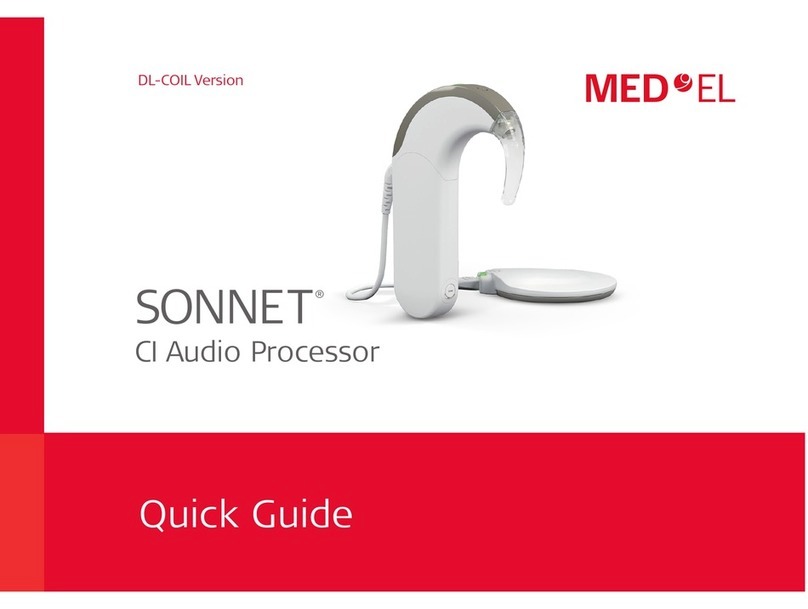
Medel
Medel SONNET User manual

Medel
Medel FineTuner Echo User manual

Medel
Medel SONNET 2 User manual

Medel
Medel OPUS 2 Operating instructions
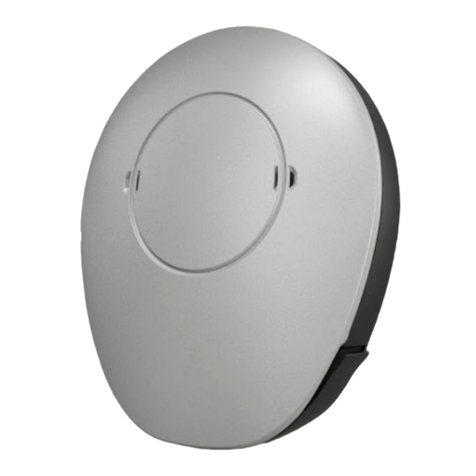
Medel
Medel Samba Assembly instructions
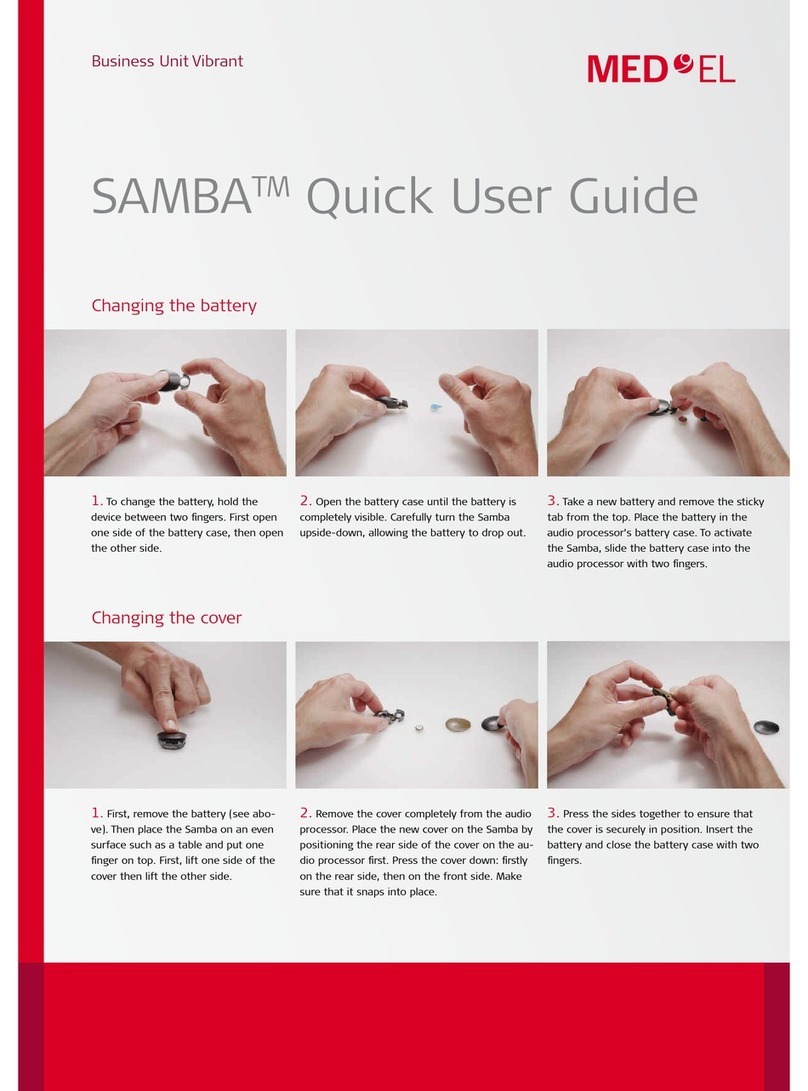
Medel
Medel SAMBA Instruction manual

Medel
Medel Samba User manual

Medel
Medel SONNET (Me1310) User manual

Medel
Medel Samba User manual

Medel
Medel OPUS 2 User manual

Medel
Medel SONNET User manual

Medel
Medel Sonnet Operating instructions

Medel
Medel RONDO 3 User manual

Medel
Medel OPUS 2 User manual
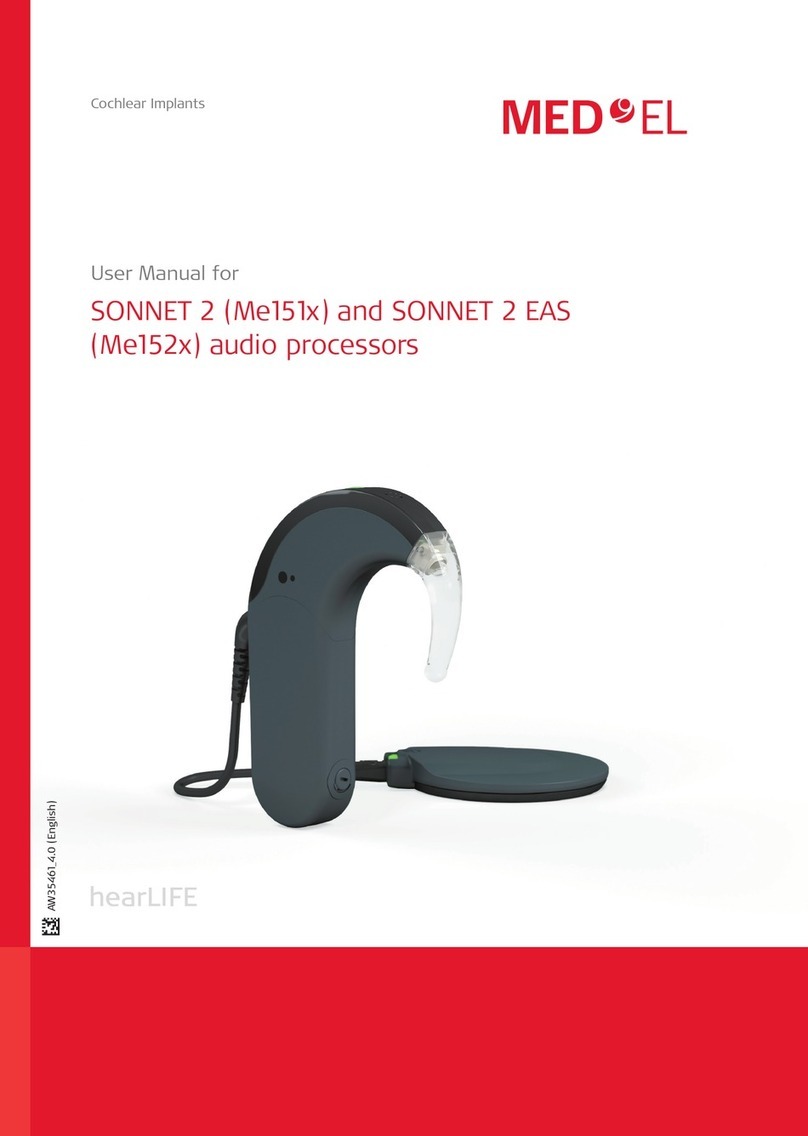
Medel
Medel Me152 Series User manual

Medel
Medel SYMFIT 6.1 User manual

Medel
Medel ADHEAR System Instruction manual

Medel
Medel OPUS 2 User manual

